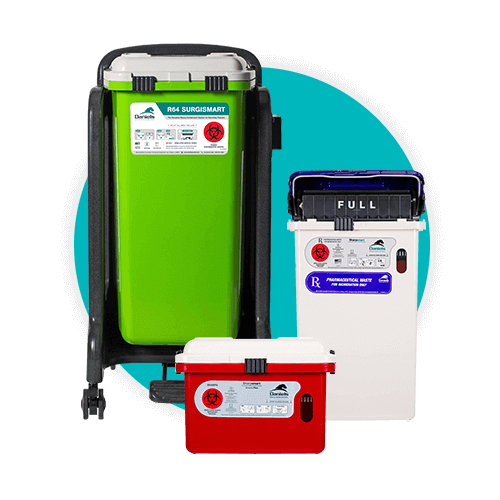Guide to Ohio Medical Waste Regulations

If you work in any medical or healthcare capacity in the state of Ohio, the importance of understanding medical waste regulations is not to be underestimated. Ohio’s governing laws regarding medical waste, hazardous waste disposal and handling, treatment, and disposal guidelines for infectious waste are found in their Administrative Code.
Numerous resources are available and applicable to healthcare facilities in Ohio that include but are not limited to hospitals and outpatient centers, but dental offices, veterinary facilities, and yes, even tattoo or body piercing businesses, regardless of size.
Ohio is very specific about regulations applicable to medical waste generators (large or small), as well as approved waste treatment methods. State agencies are sticklers regarding permits and licenses, storage requirements, and disposal guidelines for various healthcare waste segregation and waste stream management and disposal. It is strongly recommended that individuals access and read through state administrative codes to ensure compliance. Lack of compliance leads to huge fines and penalties and are not limited to major hospitals.
Ohio medical waste basics
Daniels Health has decades of experience when it comes to the labeling, storage, and disposal of all types of medical waste and healthcare waste stream processes. Do you? Technology and advancements in materials provides healthcare or medical facilities today with the latest updated equipment that enhances safety in the workplace.
However, we also recommend that every medical waste generator take a cradle-to-grave approach to healthcare waste management. This ensures compliance and reduces the risk of penalties levied by state healthcare agencies, or federal government regulatory authorities.
Do you know the law? Did you know that medical waste generators are responsible for where their medical waste ends up? Yes, this is even applicable to healthcare providers that hire medical waste pickup companies. That’s what the cradle-to-grave approach is all about. Knowing how and where your chemotherapy waste, your biohazard waste, or your pathological waste ends up. Become familiar with Ohio Administrative Codes 3745-27-30 through 3745-27-39 for pertinent information that all generators should know about. Pay specific and close attention to Ohio’s revised code for §3734.021 regarding infectious waste.
Begin your review of Ohio’s healthcare waste management codes with chapter 3745-27 Solid Waste and Infectious Waste Regulations, Section 01 under definitions. Before your medical facility or your employees can determine exactly what is required of them in regard to medical waste disposal, specific definitions for the state of Ohio apply. For example, an “infectious agent” in Ohio is defined as a “type of microorganism, pathogen, virus, or proteinaceous infectious particle that can cause or significantly contribute to disease in or death of human beings”.
“Hazardous waste” is defined as anything that is specifically listed as hazardous waste or exhibits one or more characteristics of hazardous waste as defined in chapter 3745-51 of the Administrative Code. Yes, we know that reading specific regulations, rules, and codes applicable to any state may have to bounce back and forth between different sources, but taking the time to do so is encouraged.
Chapter 3745-51 (Identification and Listing of Hazardous Waste) is especially valuable in regard to understanding the scope and purpose of this particular administrative code. Within this chapter, readers will find very specific definitions of hazardous waste (3745-51-03). This ruling defines specific characteristics of hazardous waste, mixtures of waste, and how they are to be handled, including wastewater – dentists, pay attention!
Yes, the scope of just this one chapter of Ohio’s Administrative Code, and Ohio’s Environmental Protection Agency can seem daunting. There’s a code for everything:
- Definition of waste: 3745-51-02
- Definition of hazardous waste: 3745-51-03
- Special requirements for hazardous waste generated by conditionally exempt small quantity generators: 3745-51-05
- Residues of hazardous waste and empty containers: 3745-51-07
- PCP wastes regulated under the Toxic Substances Control Act: 3745-51-08
- Criteria for listing hazardous waste: 3745-51-11
- Characteristics of hazardous waste (general): 3745-51-20
There’s more. Lots more. Daniels Health is experienced in helping our clients weigh through dozens if not hundreds of regulations based on state guidelines. Every state has slightly different definitions or guidelines regarding medical waste management on top of federal regulations.
Do you know the limitation for being defined as a medical waste generator of infectious waste? We do. Per Ohio’s EPA codes, a business that generates more than 50 pounds of infectious waste is mandated to register with Ohio’s EPA, among other regulations. This is to make sure that infectious waste is treated properly before disposal. On-site treatment technologies must be approved, or before such waste is transported to a commercial medical waste disposal company.
Did you know that in Ohio, approved treatments for infectious waste commonly utilize either autoclave or incineration prior to disposal? Ohio also approves chemical treatments that use a bleach solution for cultures and stocks, and does allow heat encapsulation for sharps decontamination. On-site medical waste disposal or treatment prior to transport must be approved beforehand. Infectious waste or hazardous material transportation is overseen by the Public Utilities Commission of Ohio.
These are just a few medical waste considerations that medical waste generators in Ohio must be aware of. Ohio’s EPA government website provides downloadable materials for large generators of infectious waste (more than 50 pounds of infectious waste generated during a calendar month) and small medical waste generators (less than 50 pounds of infectious waste generated during a calendar month).
Medical waste generators in Ohio should also keep up with amendments and statutory changes. Did you know that since 2014, Ohio’s EPA no longer has authority over the regulation of packaging, labeling, and transportation of infectious waste? Specifics can be found in Senate Bill 294. Even so, waste generators should know and understand that compliance is still applicable with the US Department of Transportation and OSHA regulations.
Senate Bill 294 specifies that generators – large and small – must segregate infectious waste at its point of generation, as well as manage that infectious waste properly and have it stored in designated and label areas.
Daniels Health helps clarify regulations
Hundreds of pages of codes, rules, legislation, regulations, amendments, and annotations are found in every states guidelines when it comes to healthcare waste management, transportation, handling, storage, and disposal. You don’t have to go it alone. We provide guidance on such regulations as well as offer sustainable, cost-effective, and efficient medical waste technologies and processes to ensure compliance.
For more information on how Daniels Health can help you not only stay compliant, but exceed safety guidelines for workers and employees, reduce sharps injury and head toward reduced carbon footprint, give us a call today.
For more information on how Daniels Health can help your facility stay on top of ever-changing guidelines and regulations, contact us today. Alternatively find out more about our Ohio operations and service capabilities on our Ohio service page here.
Let's Talk!
Your time is valuable, and we don’t want to play hard to get. You can either phone us directly on the details listed on our contact page, or feel free to fill out this short form and one of our team members will get back to you as quickly as possible.
